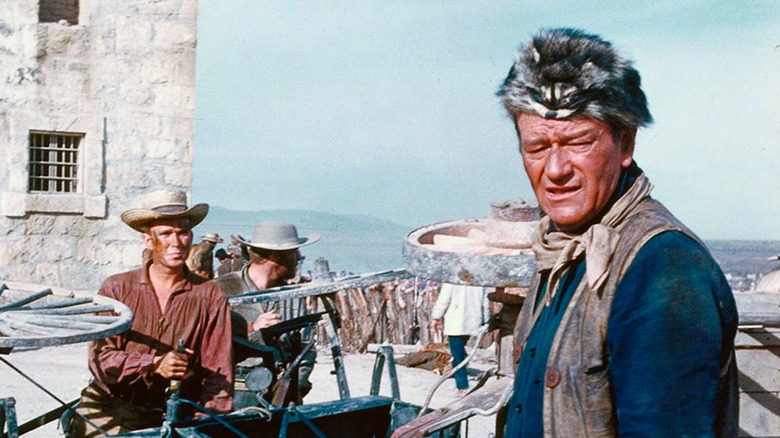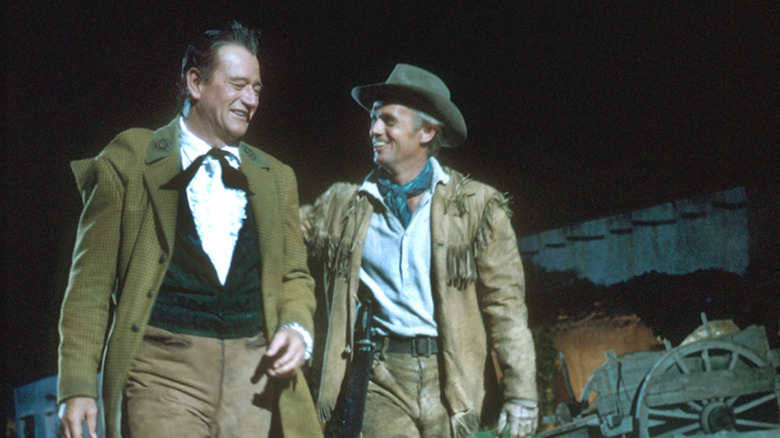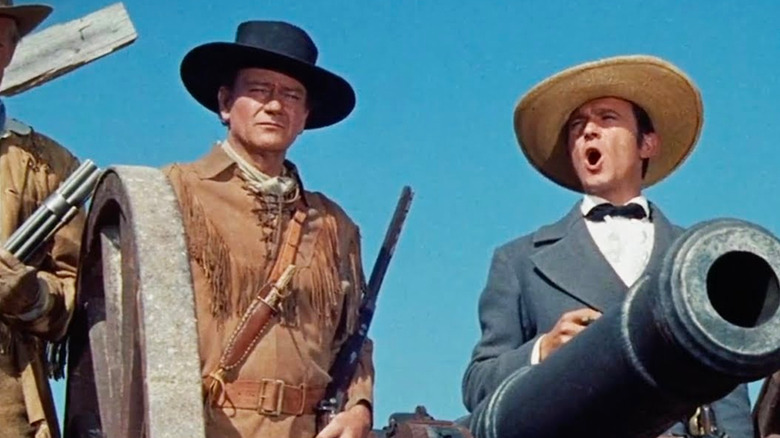John Wayne Went To War With The Studio System To Get The Alamo Made
Given the ambitious nature of "The Alamo," it's only fair to call John Wayne's passion project an epic. But getting the Western made also required an epic amount of determination: According to Aissa Wayne, the actor-turned-director's daughter, Wayne had been pitching the film since the early '50s, but struggled to get any financiers on board (fun fact: the funding delays made it possible for Aissa Wayne, who was born in 1956, to appear in "The Alamo" — perhaps a silver lining for her father).
Now, John Wayne enjoyed plenty of popularity in the '50s, so in theory, it should've been relatively easy for the Duke to get his film made. But Wayne tried to drive a hard bargain. As his daughter would reveal, Wayne wanted to produce and direct "The Alamo" — but stay behind the camera. In the studios' eyes, this was unacceptable. The project was a massive gamble (especially since Wayne had never directed before), and having a big name play a leading role would surely mitigate some of the financial risk.
Although Wayne was eventually forced to compromise — he did in fact star in "The Alamo" — the would-be director wasn't afraid to float his options, either. As a making-of documentary would note, Wayne would leave his contract with Republic Studios over creative differences.
In the end, United Artists would take the project on. But according to Aissa Wayne, the arrangement still wasn't ideal:
"My father had to sign a three-picture deal. He had to star in "The Alamo" as well as produce and direct. His production company, Batjac, had to contribute hefty financing of its own ... When [Wayne] tried financing "The Alamo" himself, he was told by his personal manager that several of his investments had gone drastically wrong."
The Alamo was an expensive gamble
With his own money on the line, the film's director/producer/star had to be prudent — it isn't exactly cheap to shoot an epic with an original theatrical release runtime of nearly 200 minutes. Fortunately, by wearing so many hats (the term "leading man" has never been so fitting), Wayne was able to both minimize salaries and maintain control over his picture. In a similar vein, the director had the expansive set of "The Alamo" custom-built, which allowed each building to best facilitate Wayne's vision and cut down on the need to rent expensive soundstages.
That being said, if you're reading this and thinking "Hey! Building a relatively large set sounds expensive! That's a strange move if you're tight on cash!", you can probably guess what happens next. "The Alamo" quickly blew through its budget — and became the most expensive movie ever made — placing massive financial strain on its director. By the time the film was complete, Wayne had invested his own savings, borrowed cash from friends, and even took out a mortgage on his home (via MySanAntonio). Ultimately, the Duke was counting on "The Alamo" to be a royal success.
United Artists tried to help out
To their credit, United Artists was just as hopeful that the film would do well. As the film neared its release date, the studio gave "The Alamo" a ridiculously intense publicity campaign: advertisements implied that watching the film was one's civic duty, and seven states organized an "Alamo Day" that commemorated the real-life battle upon which the film was based (as wild as this all sounds, I can't help but wish that today's publicity teams would come up with equally outlandish ideas. On a completely unrelated note, National Barbie Day is already celebrated on March 9. Warner Bros, the ball's in your court).
Unfortunately though, despite United Artists' best efforts, the gamble didn't pay off: "The Alamo" only made back $7,900,000 of its $12,000,000 expenses. Ironically, the film would become a kind of precursor to "Heaven's Gate," another Western epic whose director insisted on a great degree of control, only for box office metrics to falter. Granted, Wayne didn't do quite as much damage — "Heaven's Gate" lost so much money that it essentially bankrupted United Artists — but the box office performance of "The Alamo" did hint towards the dangers that could arise when a director was allowed to do whatever he pleased. John Wayne may have won his war against the studios, but the box office was another beast.


